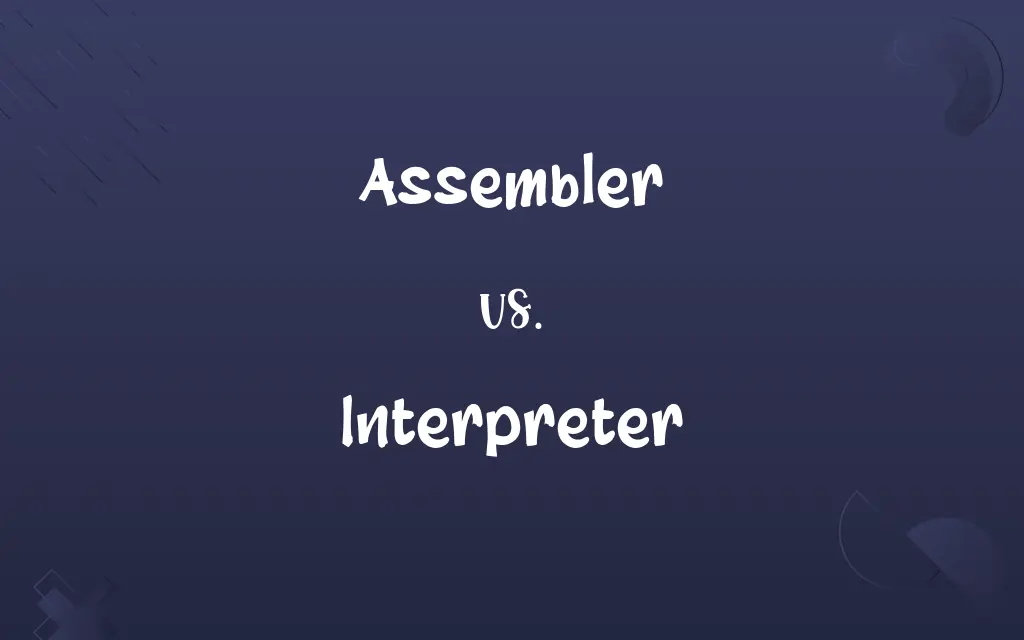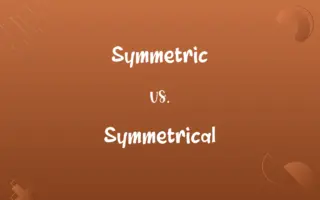Assembler vs. Interpreter: Know the Difference

By Shumaila Saeed & Dua Fatima || Published on September 4, 2024
Assembler translates assembly language into machine code, specific to hardware architecture. Interpreter directly executes instructions written in a high-level language, offering platform independence.

Key Differences
An assembler converts assembly language, a low-level programming language closely related to machine code, into executable machine code. This process is specific to a particular hardware architecture. In contrast, an interpreter directly executes instructions written in a high-level programming language without converting them to machine code, making it more flexible and platform-independent.
Dua Fatima
Sep 04, 2024
The assembler's output is a binary file that can be executed directly by the computer's hardware, leading to faster execution times since the translation happens only once. On the other hand, an interpreter reads the high-level code, translates it into machine instructions, and executes it on the fly, which can result in slower execution since this translation happens every time the program runs.
Shumaila Saeed
Sep 04, 2024
Assemblers work closely with the hardware, requiring developers to manage resources manually and have a deep understanding of the underlying architecture. Interpreters abstract away the hardware specifics, allowing developers to focus on the logic of their programs without worrying about memory management and other low-level details.
Dua Fatima
Sep 04, 2024
Assemblers generate machine code specific to a processor, the programs they produce are not portable across different types of hardware. Conversely, because interpreters work with high-level languages that are not tied to any specific machine architecture, programs written for interpreters are generally more portable and can run on any system with the appropriate interpreter.
Shumaila Saeed
Sep 04, 2024
Debugging in assembly language can be more challenging due to its low-level nature and closer proximity to machine code. Interpreter environments, however, often come with advanced debugging tools and error messages that are easier to understand, making it simpler to find and fix issues in the code.
Dua Fatima
Sep 04, 2024
ADVERTISEMENT
Comparison Chart
ADVERTISEMENT
Assembler and Interpreter Definitions
Assembler
Requires understanding of computer architecture.
Using an assembler necessitates knowledge of registers and operations.
Hifza Nasir
Feb 26, 2024
Interpreter
Executes high-level programming languages.
An interpreter runs Python code directly from the script.
Hifza Nasir
Feb 26, 2024
Assembler
Generates executable files.
The output of an assembler is a .exe file ready to run on a specific CPU.
Shumaila Saeed
Feb 26, 2024
Interpreter
Facilitates rapid development.
Developers can test changes immediately without recompilation.
Dua Fatima
Feb 26, 2024
Assembler
Converts assembly language to machine code.
An assembler transforms the MOV AX, 0001h instruction into binary code.
Shumaila Saeed
Feb 26, 2024
ADVERTISEMENT
Interpreter
Slower than compiled languages.
Interpreted languages trade execution speed for flexibility.
Dua Fatima
Feb 26, 2024
Assembler
Specific to hardware architecture.
Assemblers for ARM and x86 architectures generate different machine codes.
Hifza Nasir
Feb 26, 2024
Interpreter
Translates code at runtime.
Each line of code is interpreted and executed when the program runs.
Hifza Nasir
Feb 26, 2024
Assembler
Used for performance-critical software.
System drivers are often written in assembly language for efficiency.
Dua Fatima
Feb 26, 2024
Interpreter
Enables platform independence.
The same Python script can run on Windows, macOS, and Linux.
Shumaila Saeed
Feb 26, 2024
Assembler
A program that reads source code written in assembly language and produces executable machine code, possibly together with information needed by linkers, debuggers and other tools.
Shumaila Saeed
Jan 25, 2024
Interpreter
(computing) A program that executes another program written in a high-level language by reading the instructions in real time rather than by compiling it in advance.
Programs written in the BASIC language are usually run through an interpreter, though some can be compiled.
Shumaila Saeed
Jan 25, 2024
Repeatedly Asked Queries
What is an assembler?
An assembler is a tool that converts assembly language into machine code, specific to a computer's hardware architecture.
Dua Fatima
Sep 04, 2024
What does an interpreter do?
An interpreter directly executes instructions written in a high-level programming language without converting them to machine code first.
Shumaila Saeed
Sep 04, 2024
How do interpreters affect program portability?
Interpreters enable programs to run on any platform with the same interpreter, enhancing portability.
Shumaila Saeed
Sep 04, 2024
Is execution speed faster with an assembler or an interpreter?
Execution is faster with an assembler because it translates code to machine code once, unlike interpreters, which translate on the fly.
Shumaila Saeed
Sep 04, 2024
Do interpreters compile programs?
No, interpreters do not compile programs into machine code; they execute the high-level code directly.
Shumaila Saeed
Sep 04, 2024
Are there programming tasks that prefer assemblers over interpreters?
Yes, tasks that require high performance and access to specific hardware features, like device drivers or real-time systems.
Shumaila Saeed
Sep 04, 2024
What is a key difference in writing code for an assembler vs. an interpreter?
Writing for an assembler requires low-level hardware knowledge, while interpreters allow for more abstract and high-level programming.
Shumaila Saeed
Sep 04, 2024
What makes debugging easier in interpreted languages?
Interpreted languages often come with comprehensive debugging tools and clearer error messages.
Dua Fatima
Sep 04, 2024
Why is an assembler considered low-level?
Because it works closely with machine code and hardware-specific instructions, requiring detailed knowledge of the hardware.
Shumaila Saeed
Sep 04, 2024
Why might someone choose to use an assembler?
For low-level programming that requires direct hardware manipulation, efficiency, and speed, such as in embedded systems.
Shumaila Saeed
Sep 04, 2024
Can assembler output run on different types of computers?
No, assembler output is specific to the type of computer it was designed for due to its dependence on hardware architecture.
Shumaila Saeed
Sep 04, 2024
Why might execution be slower with an interpreter?
Because the interpreter translates high-level instructions to machine code in real-time, adding overhead to execution.
Shumaila Saeed
Sep 04, 2024
What are the benefits of using an interpreter?
Ease of use, platform independence, and no need for compilation, making it suitable for rapid development and prototyping.
Dua Fatima
Sep 04, 2024
Can you use an interpreter for any programming language?
Not all languages are designed for interpretation; some are compiled languages, though some languages can be both interpreted and compiled.
Shumaila Saeed
Sep 04, 2024
How does an assembler handle errors?
Assemblers typically generate errors related to syntax or hardware-specific issues, requiring detailed manual debugging.
Hifza Nasir
Sep 04, 2024
Share this page
Link for your blog / website
HTML
Link to share via messenger
About Author
Written by
Shumaila SaeedShumaila Saeed, an expert content creator with 6 years of experience, specializes in distilling complex topics into easily digestible comparisons, shining a light on the nuances that both inform and educate readers with clarity and accuracy.
Co-written by
Dua Fatima





































































